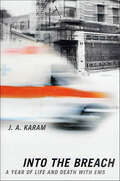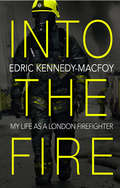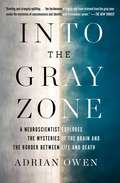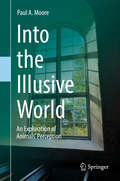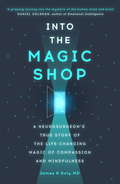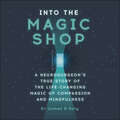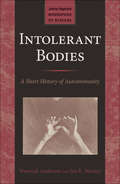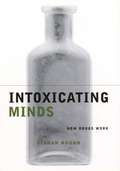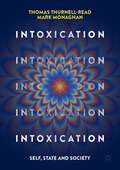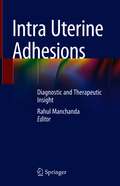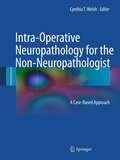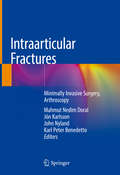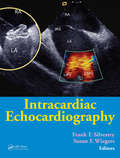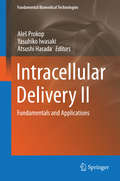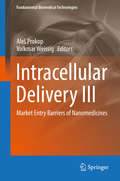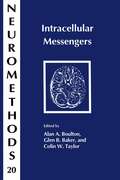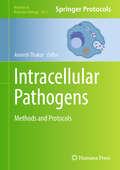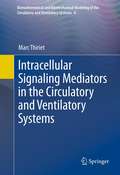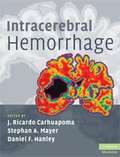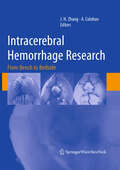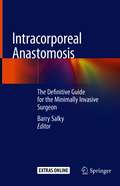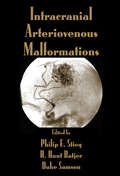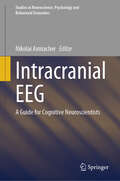- Table View
- List View
Into the Breach: A Year of Life and Death with EMS
by J. A. KaramInto the Breach is the true story of paramedics, emergency medical technicians, and heavy-rescue specialists fighting to control trauma and medical emergencies in one of America's toughest and most violent cities: Newark, New Jersey. A riveting account that hauls readers on a first-hand tour of street medicine today, Into the Breach shows what really happens inside an ambulance and some of the diverse and bizarre places EMS workers tread. Through authentic accounts, every facet of emergency care is on display-from the first 911 call to patient discharge or death, including an exclusive look at what is perhaps the biggest decontamination operation ever conducted, which crews performed for victims of the September 11, 2001 terrorist attack. A hybrid profession that blends public safety and public health, EMS attracts careerists and volunteers from all sectors of society-from Boy Scouts and housewives to Fortune 500 vice presidents and work-fare recipients. The men and women that make up the Newark EMS graveyard shift, one of the busiest, full-time teams in the nation, are quintessential EMS workers: intense, irreverent, hard-working action junkies who crave autonomy and the instant gratification of solving critical problems in real time. This unflinching profile hones in on award-winning EMS workers as well as those who pollute the industry, ironically, sometimes one and the same.Into the Breach offers an unusual opportunity to bear witness to unimaginable suffering, heroic stoicism, and the inventiveness of American EMS workers fighting to save lives.
Into the Fire: My Life as a London Firefighter
by Edric Kennedy-Macfoy___________________'Deeply personal and blisteringly powerful.’ Tom Marcus, author of SOLDIER SPYThe incredible true story of life as a London firefighter. What is it really like to be a firefighter? How does it feel to respond to an emergency call, to know that someone's life hangs in the balance and every second is critical?Into the Fire offers an unforgettable insight into the highs and lows of life in the fire service. Chronicling his thirteen-year career in the London Fire Brigade, Edric Kennedy-Macfoy takes us with him from his training days as a new recruit to his very first fire; from call-outs to cannabis farms, chemical spills and trapped swans to the devastating scenes of road traffic collisions, the Croydon tram derailment and the Grenfell Tower fire.Heart-breaking, deeply personal and at times hilarious, this is his remarkable story.
Into the Gray Zone: A Neuroscientist Explores the Border Between Life and Death
by Adrian OwenIn this &“riveting read, meshing memoir with scientific explication&” (Nature), a world-renowned neuroscientist reveals how he learned to communicate with patients in vegetative or &“gray zone&” states and, more importantly, he explains what those interactions tell us about the working of our own brains.&“Vivid, emotional, and thought-provoking&” (Publishers Weekly), Into the Gray Zone takes readers to the edge of a dazzling, humbling frontier in our understanding of the brain: the so-called &“gray zone&” between full consciousness and brain death. People in this middle place have sustained traumatic brain injuries or are the victims of stroke or degenerative diseases, such as Alzheimer&’s and Parkinson&’s. Many are oblivious to the outside world, and their doctors believe they are incapable of thought. But a sizeable number—as many as twenty percent—are experiencing something different: intact minds adrift deep within damaged brains and bodies. An expert in the field, Adrian Owen led a team that, in 2006, discovered this lost population and made medical history. Scientists, physicians, and philosophers have only just begun to grapple with the implications. Following Owen&’s journey of exciting medical discovery, Into the Gray Zone asks some tough and terrifying questions, such as: What is life like for these patients? What can their families and friends do to help them? What are the ethical implications for religious organizations, politicians, the Right to Die movement, and even insurers? And perhaps most intriguing of all: in defining what a life worth living is, are we too concerned with the physical and not giving enough emphasis to the power of thought? What, truly, defines a satisfying life? &“Strangely uplifting…the testimonies of people who have returned from the gray zone evoke the mysteries of consciousness and identity with tremendous power&” (The New Yorker). This book is about the difference between a brain and a mind, a body and a person. Into the Gray Zone is &“a fascinating memoir…reads like a thriller&” (Mail on Sunday).
Into the Illusive World: An Exploration of Animals’ Perception
by Paul A. MooreHave you ever thought about what a dog smells as it stops to sniff at a tree? Or what a cat is watching as it stares intensely off into space? What about animals in the wild? What do they see, hear, smell, and feel? How do they perceive their surroundings? This is the illusive world. A world filled with fascinating stimuli that we are not equipped to detect. This is particularly true because we tend to rely so heavily on our eyes or ears. We are figuratively, and literally, blind to this part of the natural world. This part, which is full of stimuli we cannot perceive, encompasses the daily lives of so many animals. Beneath our feet are ants, moles, and spiders using vibrations to coordinate colonies and communicate danger. In the oceans, turtles, fish, and octopi are sensitive to magnetic and electric fields, as well as tasty morsels at the tips of their tentacles. In the skies, owls and raptors can see deep into a lake or pierce the night with highly sensitive eyes. This book brings together all these animals and their amazing sensory abilities in an exploration of how animals perceive their world. Within these pages are wonderful and exciting stories of organisms using their senses to perform sophisticated communication with nestmates, find hidden prey in the dark of night or murky of depths, and call to lovers both near and far. This book will open the door to this illusive world and will take you on a journey into the illusive world and see how different the world is when perceived through another animal’s senses.
Into the Magic Shop: A neurosurgeon's true story of the life-changing magic of mindfulness and compassion that inspired the hit K-pop band BTS
by Dr James DotyThe award-winning New York Times bestseller that inspired BTS's K-pop song 'Magic Shop'. The day that 12-year-old James Doty walked in to his local magic shop is the day that changed his life. Once the neglected son of an alcoholic father and a mother with chronic depression, he has gone on to become a leading neurosurgeon, based at Stanford University. He credits Ruth for this incredible turnaround: the remarkable woman he met at the Cactus Rabbit Magic Shop, who devoted the summer to transforming his mind and opening his heart.In this uplifting memoir, Jim explains the visualisation techniques Ruth taught him that gave him the self-esteem to imagine a new future for himself. He examines the science behind mindfulness and why the skills he learned - of focus and attention - now help him to think fast and keep calm in the operating theatre. And he shows us what is possible when you start to change your brain and your heart. Into the Magic Shopimparts some powerful life lessons about how to live better, and inspires us to believe that we all have inside us the capacity to change our own destiny.'I'm sure many readers will be moved by this inspiring story to open their hearts and see what they too can do for others' - His Holiness the Dalai Lama
Into the Magic Shop: A neurosurgeon's true story of the life-changing magic of mindfulness and compassion that inspired the hit K-pop band BTS
by Dr James DotyThe award-winning New York Times bestseller that inspired BTS's K-pop song 'Magic Shop'.The day that 12-year-old James Doty walked in to his local magic shop is the day that changed his life. Once the neglected son of an alcoholic father and a mother with chronic depression, he has gone on to become a leading neurosurgeon, based at Stanford University. He credits Ruth for this incredible turnaround: the remarkable woman he met at the Cactus Rabbit Magic Shop, who devoted the summer to transforming his mind and opening his heart.In this uplifting memoir, Jim explains the visualisation techniques Ruth taught him that gave him the self-esteem to imagine a new future for himself. He examines the science behind mindfulness and why the skills he learned - of focus and attention - now help him to think fast and keep calm in the operating theatre. And he shows us what is possible when you start to change your brain and your heart. Into the Magic Shop imparts some powerful life lessons about how to live better, and inspires us to believe that we all have inside us the capacity to change our own destiny.(P) 2020 Blackstone Audio, Inc.
Intolerant Bodies: A Short History of Autoimmunity (Johns Hopkins Biographies of Disease)
by Warwick Anderson Ian R. MackayA history of autoimmunity that validates the experience of patients while challenging assumptions about the distinction between the normal and the pathological.Winner of the NSW Premier's History Award of the Arts NSWAutoimmune diseases, which affect 5 to 10 percent of the population, are as unpredictable in their course as they are paradoxical in their cause. They produce persistent suffering as they follow a drawn-out, often lifelong, pattern of remission and recurrence. Multiple sclerosis, lupus, rheumatoid arthritis, and type 1 diabetes—the diseases considered in this book—are but a handful of the conditions that can develop when the immune system goes awry.Intolerant Bodies is a unique collaboration between Ian Mackay, one of the prominent founders of clinical immunology, and Warwick Anderson, a leading historian of twentieth-century biomedical science. The authors narrate the changing scientific understanding of the cause of autoimmunity and explore the significance of having a disease in which one’s body turns on itself. The book unfolds as a biography of a relatively new concept of pathogenesis, one that was accepted only in the 1950s.In their description of the onset, symptoms, and course of autoimmune diseases, Anderson and Mackay quote from the writings of Charles Dickens, Edgar Allan Poe, Joseph Heller, Flannery O’Connor, and other famous people who commented on or grappled with autoimmune disease. The authors also assess the work of the dedicated researchers and physicians who have struggled to understand the mysteries of autoimmunity. Connecting laboratory research, clinical medicine, social theory, and lived experience, Intolerant Bodies reveals how doctors and patients have come to terms, often reluctantly, with this novel and puzzling mechanism of disease causation.
Intoxicating Minds: How Drugs Work
by Ciaran ReganWhy do smokers claim that the first cigarette of the day is the best? What is the biological basis behind some heavy drinkers' belief that the "hair-of-the-dog" method alleviates the effects of a hangover? Why does marijuana seem to affect ones problem-solving capacity? Intoxicating Minds is, in the author's words, "a grand excavation of drug myth." Neither extolling nor condemning drug use, it is a story of scientific and artistic achievement, war and greed, empires and religions, and lessons for the future. Ciaran Regan looks at each class of drugs, describing the historical evolution of their use, explaining how they work within the brain's neurophysiology, and outlining the basic pharmacology of those substances. From a consideration of the effect of stimulants, such as caffeine and nicotine, and the reasons and consequences of their sudden popularity in the seventeenth century, the book moves to a discussion of more modern stimulants, such as cocaine and ecstasy. In addition, Regan explains how we process memory, the nature of thought disorders, and therapies for treating depression and schizophrenia. Regan then considers psychedelic drugs and their perceived mystical properties and traces the history of placebos to ancient civilizations. Finally, Intoxicating Minds considers the physical consequences of our co-evolution with drugs--how they have altered our very being--and offers a glimpse of the brave new world of drug therapies.
Intoxicating Minds: How Drugs Work (Maps of the Mind)
by Ciaran ReganWhy do smokers claim that the first cigarette of the day is the best? What is the biological basis behind some heavy drinkers' belief that the "hair-of-the-dog" method alleviates the effects of a hangover? Why does marijuana seem to affect ones problem-solving capacity? Intoxicating Minds is, in the author's words, "a grand excavation of drug myth." Neither extolling nor condemning drug use, it is a story of scientific and artistic achievement, war and greed, empires and religions, and lessons for the future. Ciaran Regan looks at each class of drugs, describing the historical evolution of their use, explaining how they work within the brain's neurophysiology, and outlining the basic pharmacology of those substances. From a consideration of the effect of stimulants, such as caffeine and nicotine, and the reasons and consequences of their sudden popularity in the seventeenth century, the book moves to a discussion of more modern stimulants, such as cocaine and ecstasy. In addition, Regan explains how we process memory, the nature of thought disorders, and therapies for treating depression and schizophrenia. Regan then considers psychedelic drugs and their perceived mystical properties and traces the history of placebos to ancient civilizations. Finally, Intoxicating Minds considers the physical consequences of our co-evolution with drugs—how they have altered our very being—and offers a glimpse of the brave new world of drug therapies.
Intoxication: Self, State and Society
by Thomas Thurnell-Read Mark MonaghanWhat images come to mind when you read the word ‘intoxication’? What behaviour do you associate with the word ‘drunk’? When you hear the word ‘drug’, what images do you recall? This textbook provides an essential and thorough grounding in debates about the role of intoxication in contemporary society, from social and cultural perspectives. It examines intoxication in the broadest sense as including both legal and illegal substances and both culturally accepted and socially stigmatised practices. Given the pace of recent changes in policy and practice – from the increasingly common legalisation of cannabis, to the recent trend of sobriety amongst adolescents and young adults – this book stands out by offering both a through historical and theoretical overview and a topical and forward looking exploration of current debates. It adopts a multi-scale approach to examine wider patterns of change so it considers the subjective experiences of the role intoxication plays in the lives of individuals and groups, in the construction of diverse identities and how this differs by age, gender and ethnicity. The authors play particular attention to the way in which the state justifies interventions based on moral, health and criminal justice discourses and also consider the role played by other individuals and institutions, not least the mass media and the alcohol industry, in propagating and challenging common sense explanations of intoxication. It speaks to undergraduates, master's students and above, with a range of pedagogic features, and offers insights into policy and practice.
Intra Uterine Adhesions: Diagnostic and Therapeutic Insight
by Rahul ManchandaThe book covers the entire aspect of intrauterine adhesions and Asherman's syndrome highlighting important points. It discusses etiopathogenesis to diagnosis and the current guidelines with effective treatment policies. It covers new treatment techniques, use of stem cell therapy and various scenarios with the best management of them. The book also covers pregnancy and associated complications. It takes into account the vast clinical experience of the authors all over the world clubbed with the academic evidence available to date.The book is relevant for endoscopic surgeons, hysteroscopists, infertility specialists and obstetricians at large, and anyone who wishes to know more about this subject.
Intra-Abdominal Hypertension
by Manu Malbrain Jan De WaeleDespite increasing interest in intra-abdominal hypertension (IAH) and abdominal compartment syndrome (ACS) as causes of significant morbidity and mortality among the critically ill, unanswered questions cloud the understanding of the pathophysiology of these conditions: • Are IAH and ACS synonymous? • What are the ideal methods of measuring and lowering intra-abdominal pressure (IAP)? • When should we think of IAH? • Can IAH be prevented? • What level of IAP requires abdominal decompression? Written by two experts in critical care and IAP, Intra-Abdominal Hypertension is a distillation of the current literature and furthers the understanding of these complex critical conditions. Using a step-by-step approach and illustrative figures, this clinical handbook presents a concise overview of consensus definitions, measurement methods, organ assessment and treatment options. Intra-Abdominal Hypertension is essential reading for all members of the intensive care multidisciplinary team, including experienced and junior physicians, anesthetists and nurses.
Intra-Operative Neuropathology for the Non-Neuropathologist
by Cynthia T. WelshThis volume acquaints the non-neuropathologist with the advantages of clinical-radiologic-pathologic correlation in neuropathology specimens, particularly in the intra-operative consultation. As a good cytology preparation can add to, or even supply in isolation, a diagnosis, this volume covers the enormous and sometimes insurmountable artifacts involved with freezing tissue, especially central nervous system tissue. The text presents how to perform, and stain the cytologic preparations, and how to interpret them. The advantages and disadvantages of both frozen sections and cytologic preparations of various kinds are discussed. The presentation and format is very visual with diagrams, tables, with many figures including pearls and pitfalls and therefore easy reading. An introductory chapter presents the pros and cons of cytology, the advantages and disadvantages of frozen sections, and the artifacts in both. Also included is an argument for knowing what the scans reveal, and the impact of relevant patient history. The volume uses a case-based approach to show correlation between scan, history, frozen section and cytologic preparations. With the combination of extensive correlation of scans, cytology, and frozen section with differential diagnosis, and analysis of the information crucial to the neurosurgeon in a case-based approach and with a special chapter written by a neuroradiologist, this volume is unique in presentation and utility and will be of great value to the trainee in pathology (residents/fellows), and practicing pathologists who include neuropathology in their practice, but do not have formal fellowship training in neuropathology.
Intraarticular Fractures: Minimally Invasive Surgery, Arthroscopy
by Mahmut Nedim Doral Jón Karlsson John Nyland Karl Peter BenedettoThis superbly illustrated book is a comprehensive and detailed guide to the contemporary arthroscopic management of intraarticular fractures. The opening section addresses a variety of basic aspects and key issues, including the difficulties posed by intraarticular fractures, principles of fixation, cartilage healing, and rehabilitation. The minimally invasive surgical techniques appropriate to individual types of fracture are then fully described and depicted, covering fractures of the shoulder and elbow, wrist, pelvis and hip, knee, and ankle. Guidance is also provided on avoidance and management of complications and rehabilitation. The closing section addresses relevant miscellaneous issues, including arthroscopic management of temporomandibular joint fractures and extended indications for endoscopy-assisted fracture fixation. This volume will be of value for both trainee and experienced surgeons when treating patients with these complex fractures.
Intracardiac Echocardiography
by Susan E. Wiegers Frank E. SilvestryIntracardiac Echocardiography is the first echocardiographic textbook of its kind to specifically cover ICE. Discussing all aspects of intracardiac ultrasound, it allows readers to perfect ICE image acquisition and helps to guide interpretation of this information during interventional and electrophysiologic procedures.Unique and informative, the text explores:introductory echo physics currently available intracardiac ultrasound systems basic image acquisitionthe role of ICE in both the interventional and electrophysiology laboratory, as well as in the diagnostic setting. Featuring expert commentary by leaders in the field, the book also includes high quality echocardiographic images illustrating how ICE is used in a wide variety of procedures such as transseptal catheterization, PFO and ASD closure, atrial fibrillation ablation procedures, and many others.
Intracellular Delivery II
by Aleš Prokop Yasuhiko Iwasaki Atsushi HaradaThis volume is a continuation of Volume 1 following the previously published Editorial. More emphasis is given to novel nanocarrier designs, their characterization and function, and applications for drug discovery and treatment. A number of chapters will deal with nanofibers as a new major application within the biomedical field with a very high success rate particularly in wound healing and diabetic foot and spine injuries. A major new subdivision will deal with mathematical methods for the assembly of nanocarriers both for simulation and function.
Intracellular Delivery III
by Volkmar Weissig Aleš ProkopThis book features a special subsection of Nanomedicine, an application of nanotechnology to achieve breakthroughs in healthcare. It exploits the improved and often novel physical, chemical and biological properties of materials only existent at the nanometer scale. As a consequence of small scale, nanosystems in most cases are efficiently taken up by cells and appear to act at the intracellular level. Nanotechnology has the potential to improve diagnosis, treatment and follow-up of diseases, and includes targeted drug delivery and regenerative medicine; it creates new tools and methods that impact significantly existing conservative practices. This volume is a collection of authoritative reviews concentrating on cellular and organelle delivery and targeting, and ways of identifying targets by biochemical and computational means.
Intracellular Messengers
by Alan A. Boulton Glen B. Baker Colin W. TaylorThis timely new volume in the highly acclaimed Neuromethods series focuses on major new advances in understanding the signaling mechanisms employed by neural tissues. Chapters, contributed by experts in the field, provide thorough, up-to-date coverage of a variety of topics and techniques, including: single-cell imaging technology * phosphorylation of target proteins * analysis of phosphoinositides and inositol phosphates * inositol trisphosphate and intracellular calcium * guanine nucleotide-binding proteins * ion channel gating * measurement of intracellular calcium with fluorescent calcium indicators * protein kinase C * synthetic analogs of intracellular messengers * cyclic nucleotides * caged intracellular messengers * intracellular regulators and components of the exocytotic pathway * intracellular messengers in vertebrate and invertebrate photoreceptors. Neuromethods 20 * Intracellular Messengers is an essential resource for neurobiologiests at all levels of research.
Intracellular Pathogens: Methods and Protocols (Methods in Molecular Biology #2813)
by Aneesh ThakurThis detailed volume presents cutting-edge approaches to study infection, immunity, and intervention strategies against intracellular pathogens. The book explores areas such as how intracellular pathogens infect and survive inside the phagocytes, immunopathological features of infection, evasion of host-induced immune responses, cellular crosstalk in the presence of intracellular pathogens, host innate and adaptive immunity, and much more. Written for the highly successful Methods in Molecular Biology series, chapters include introductions to their respective topics, lists of the necessary materials and reagents, step-by-step and readily reproducible laboratory protocols, and tips on troubleshooting and avoiding known pitfalls. Authoritative and practical, Intracellular Pathogens: Methods and Protocols serves as an ideal guide for researchers who work with intracellular pathogens and want to utilize or refine strategies to study, treat, or controlthem.
Intracellular Signaling Mediators in the Circulatory and Ventilatory Systems
by Marc ThirietThe volumes in this authoritative series present a multidisciplinary approach to modeling and simulation of flows in the cardiovascular and ventilatory systems, especially multiscale modeling and coupled simulations. The cardiovascular and respiratory systems are tightly coupled, as their primary function is to supply oxygen to and remove carbon dioxide from the body's cells. Because physiological conduits have deformable and reactive walls, macroscopic flow behavior and prediction must be coupled to phenomenological models of nano- and microscopic events in a corrector scheme of regulated mechanisms when the vessel lumen caliber varies markedly. Therefore, investigation of flows of blood and air in physiological conduits requires an understanding of the biology, chemistry, and physics of these systems together with the mathematical tools to describe their functioning. Volume 4 is devoted to major sets of intracellular mediators that transmit signals upon stimulation of cell-surface receptors. Activation of signaling effectors triggers the release of substances stored in cellular organelles and/or gene transcription and protein synthesis. Complex stages of cell signaling can be studied using proper mathematical models, once the role of each component is carefully handled. Volume 4 also reviews various categories of cytosolic and/or nuclear mediators and illustrates some major signal transduction pathways, such as NFkappaB axis, oxygen sensing, and mechanotransduction.
Intracerebral Hemorrhage
by J. Ricardo Carhuapoma Stephan A. Mayer Daniel F. HanleyIntracerebral hemorrhage is a neurovascular emergency associated with high mortality and morbidity. With in-depth reviews of the clinical and biological aspects of the condition, this text provides an up-to-date coverage of this form of stroke. The book covers epidemiology, causes, clinical presentation, management and prognosis, and describes the ongoing research advances aimed at improving our understanding of the condition. The book fills an existing gap in the medical literature. The chapters discussing the clinical aspects of intracerebral hemorrhage are aimed at the practitioner directing the care of stroke victims. Chapters exploring the biology of pathophysiological events triggered by this disease will provide readers with current data directed to facilitate experimental research in this field of cerebrovascular neurology. It will appeal to clinicians and those with a research interest in cerebrovascular diseases.
Intracerebral Hemorrhage Research
by Austin Colohan John ZhangThe volume includes 75 papers which were presented at the Third International Conference on Intracerebral Hemorrhage, held in Rancho Mirage, California, in March 2010. The topics treated include animal models, pathophysiology of cerebral hemorrhage, experimental treatment for cerebral hemorrhage, cerebral hemorrhage clinical manifestations, prognosis of cerebral hemorrhage, and clinical management. The articles represent the recent advances in hemorrhagic brain injury research presented by highly respected laboratories around the world.
Intracorporeal Anastomosis: The Definitive Guide for the Minimally Invasive Surgeon
by Barry SalkyLaparoscopic and robotic approaches to colon, rectum and the small intestine have undergone radical change since the introduction of minimally invasive surgical techniques. At the beginning of this revolution, the most common anastomotic techniques have been extracorporeal. As a few surgeons became more familiar with minimally invasive suturing techniques, intracorporeal anastomosis became possible. However, the change from an extracorporeal approach has been slow to realization for the vast majority of surgeons. While there are multiple reasons for this slow adoption, the most common are perceived difficulty with suturing in a closed space, the feeling of lack of control, and the worry of increased infection in the abdomen. This book details the latest information in addressing and dispelling these fears. It provides a useful guide to techniques required to perform intracorporeal anastomoses both in laparoscopic and robotic surgery, and it shows the huge advantages to the patient, surgeon and to our health care system. Written by experts in the field, chapters serve as a definitive guide to the performance of intracorporeal techniques to all general and colon and rectal surgeons performing bowel resection both for benign and malignant disease. The chapters contain ample color photographs and videos describing each technique.Intracorporeal Anastomosis primarily focuses on laparoscopic and robotic techniques and contains the latest published data describing the advantages of using these minimally invasive surgical techniques.
Intracranial Arteriovenous Malformations
by Philip E. Stieg H. Hunt BatjerOffering expert recommendations and selected color illustrations, this guide furnishes readers with state-of-the-art information on the pathophysiology, diagnosis, evaluation, and treatment of AVMs. Offering a multidisciplinary approach, this book spans a wide array of therapeutic options and surgical approaches with step-by-step presentations of e
Intracranial EEG: A Guide for Cognitive Neuroscientists (Studies in Neuroscience, Psychology and Behavioral Economics)
by Nikolai AxmacherThis book offers the first, comprehensive guide to planning and conducting intracranial EEG studies, and analyzing intracranial EEG data. The chapters address core questions in the field of intracranial EEG research. They are written by internationally recognized experts in the domain of intracranial EEG and acknowledge the heterogeneity of approaches in this field. The particular format of the book allows readers to find clear guidelines, hands-on expertise and invaluable background information for planning and conducting state-of-the-art intracranial EEG research projects. Besides offering a reference guide to newcomers in the field, it also provides scholarly information for the more experienced researcher and inspiration for the expert. The book covers a wide range of topics, with a special emphasis on aspects in which intracranial EEG data differ from other types of data in the cognitive neurosciences. It discusses typical patient characteristics and implantation schemes, ethical issues, and practical considerations for planning and running intracranial EEG experiments. It addresses signal characteristics and the physiological background of oscillatory and non-oscillatory aspects of intracranial EEG signals. It describes complex pre-processing steps such as advantages and disadvantages of different referencing schemes, and how to identify the location of electrodes. In addition, it answers specific questions on data processing, addressing core aspects of statistical analysis, and suggesting guidelines for data presentation. Further, it covers advanced topics such as causal interventions (i.e. deep brain stimulation), acquisition and analysis of single-unit data and multimodal recordings, and discusses important future challenges and opportunities in the field of intracranial EEG research.
